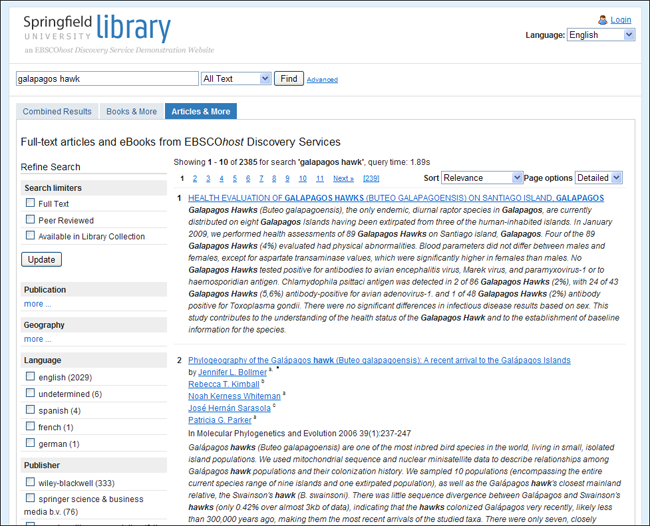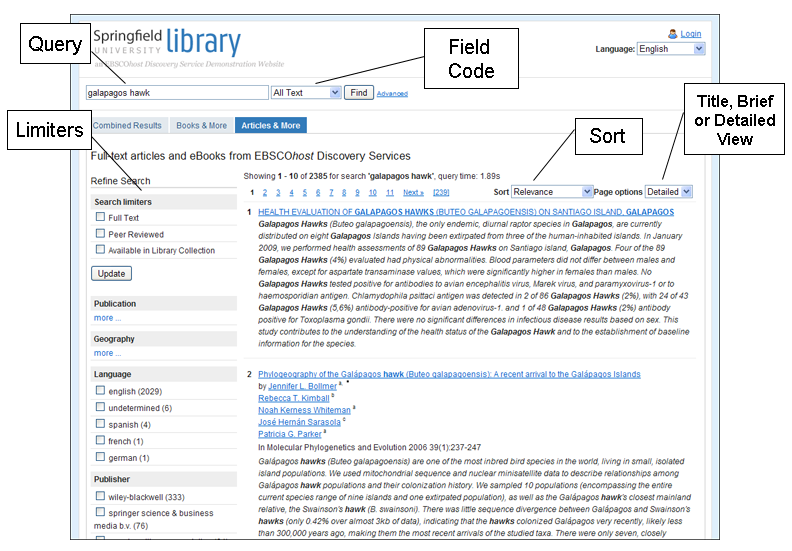Designing Your Search Screen
When working with EDS API, it is important to consider your search screen design. EDS API offers many options for displaying search results, limiters and expanders. Below is an example search screen from VuFind, a popular open source catalog search platform. This example illustrates key design features that use EDS API's common UI elements. This example screen has one tab that shows books from the local catalog in the left column and articles on the right. In addition, it has a separate tab for just catalog items and one for just articles. The Articles & More tab is selected below. Therefore, the results are all articles returned from EDS. If you choose to load your catalog directly into EDS, you can opt to show all the results on one screen, with both books and articles mixed together.

Common UI Elements
- The search box defaults to searching all fields, but can also search by author, title, subject, or publication, using the Search method and the FieldCode parameter.
- Searches can be limited to records in your collection, full-text, or peer-reviewed articles, or any combination you choose using the Limiters parameter.
- Results are paginated and can be sorted. You can choose the default sort and the number of articles to retrieve per page, using Sort and Resultsperpage.
- The title can be underlined to show that users can click on it, taking them to a more detailed page. The full article is returned with the Retrieve method.
- Facets are returned with the results, showing the most common attributes of the search results. Facets are typically made click-able. The user can reduce the search results to only a particular subject, source, type of content, etc. Facets are different for every search because they’re based on the results of that search.
- Authors and publication source are shown in a different color. This is entirely a decision of the developer or designer. We provide the display value; but we also provide a “searchlink”. You can make these fields click-able and execute a search of EDS databases for that author or publication.
- A few lines of the abstract are shown and the search term is highlighted in the abstract. You can decide how much of the abstract to show, if at all. The Highlight parameter tells the API whether to highlight the search term in the results.
- Links to full text articles and the type of article are shown.
Preparing the Search Screen
Some search options need to be determined before you execute the search, and some are applied after a search.

Search Options
- FieldCodes: What options do you want to provide for search fields, and which one is displayed as default? Fieldcodes' include author, subject, title, and many others. The Info method identifies the FieldCodes available on your account. The default search is a keyword search which searches all these fields, along with the full text if the “Also search within the full text of the articles” expander is selected.
- Limiter: What limiters do you want to offer? These can include full-text, peer-reviewed, in your local collection, or dozens of others. Typically, the most commonly-used limiter is full-text, so that the results of a search are all articles to which you have full access in your EBSCO account.
- Sort: What sort options do you want to show, and which one is displayed as the default? Since EDS calculates relevance based on many factors, including date, it is the best default sort.
- View: Decide if you want to return only the Title, or a Brief view (subjects, authors, source), or a more Detailed view (including the abstract).
- RelatedContent: The ability to return additional content related to the search being performed is available. Related content can be a Research Starter or a Publication Match.
Some organizations may predetermine some of these options, like Brief View or Sort, and not present the option to users. The options are then added to the search by code, rather than selections made by users. If you use Info for limiters and sort options, you ensure that any changes made to your organization’s profile in EBSCOadmin will be reflected in the choices offered to users.
Updated about 2 years ago
